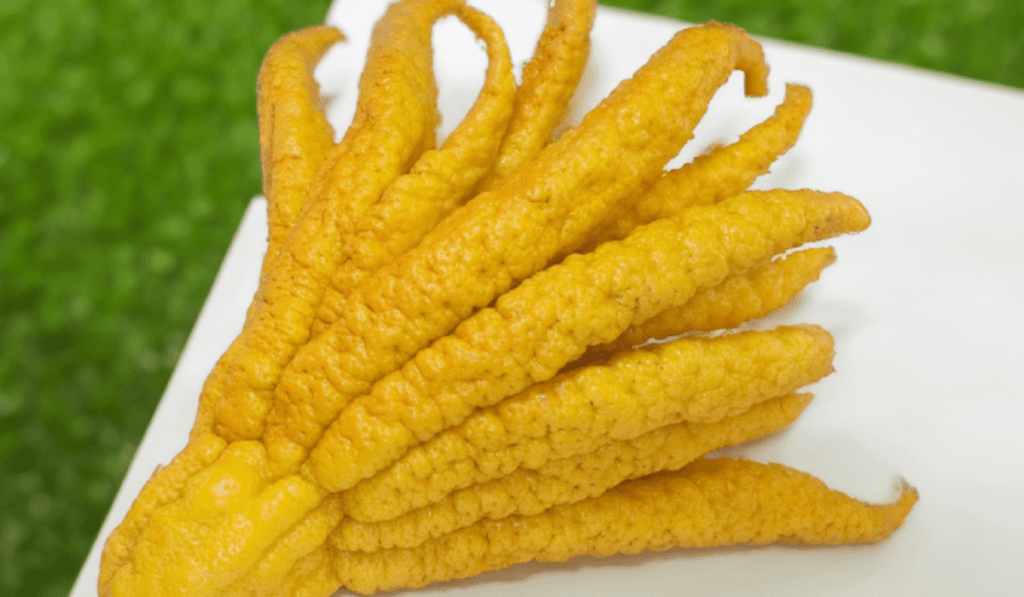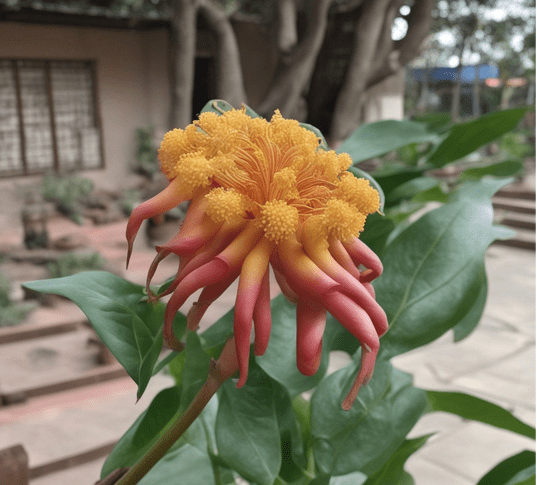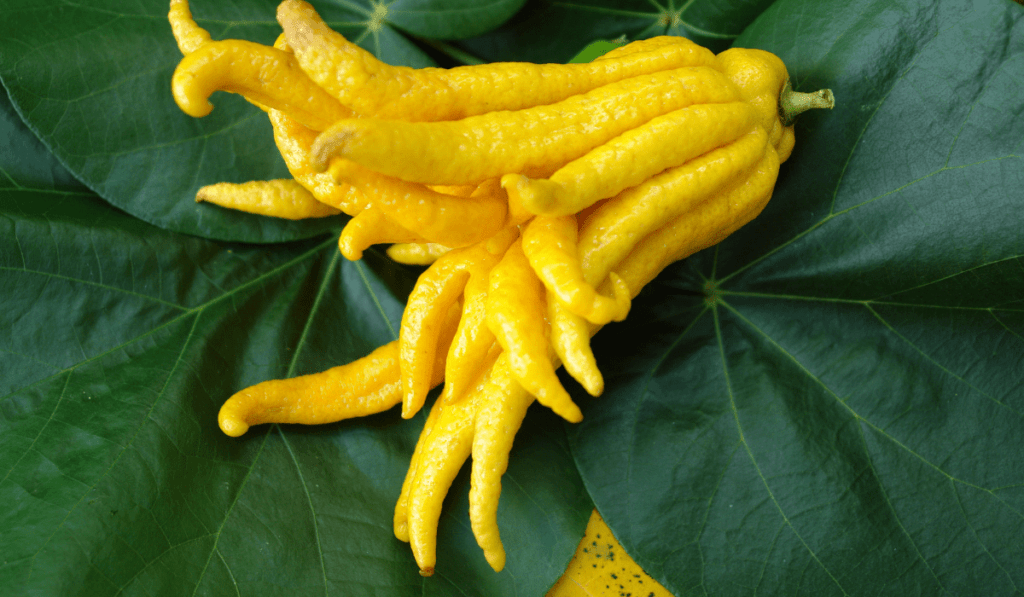Have you ever thought about growing the amazing Buddha’s Hand fruit at home? Want to know how? Well, you’re in for a treat! In this blog post, we’ll show you step by step how to grow your own Buddha’s Hand. When you finish reading, you’ll know all you need to grow this special citrus fruit in your garden. Get ready for a fragrant adventure – let’s start and discover the magic of Buddha’s Hand!
[ez-toc]
Chapter 1: Planting Basic of Buddha’s Hand
How Long Does It Take To Grow A Buddha’s hand?
The Buddha’s hand (Citrus medica var. sarcodactylis) is an unusual citrus fruit. It has segments that look like fingers. It takes between 8 to 10 years for it to grow. This is from the time it’s a seedling or young plant until it’s mature and ready to bear fruit.
Here’s a general timeline for growing Buddha’s hand:
Seedling Stage (0-2 Years):
- From a seed or small sapling, the journey begins. In the initial years, the focus is on growing the root setup, leaves, and limbs. Here, plant growth is mainly on greenery, not generating fruit.
Juvenile Stage (2-5 Years):
- As the plant gets older, it might keep getting bigger with more leaves and branches forming a wide cover. But, don’t expect fruits yet. Trees like Buddha’s hand and other citrus varieties usually need many years to start producing fruits.
Maturity and Fruit Production (5-10+ Years):
- Usually, Buddha’s hand trees start producing fruit when mature, between 5 To 10 years. Yet, growth conditions and care can extend this. Elements like soil properties, weather, trimming, feeding, and water supply can change the maturity timeline.
Fruit Development:
- When the tree becomes fully grown, it might make sweet-smelling, special fruits that look like fingers all clustered together. These fruits may need many months to grow and become ripe on the tree.
Remember, Buddha’s hand trees don’t all grow at the same speed. Some might bear fruit quicker than others. Take note that how well you care for the tree matters too. Correct watering, enough sunlight, and the right fertilizer can speed up the tree’s growth. This determines when it will start giving you fruit.
What Temperature Can Buddha’s Hand Tolerate?
Buddha’s Hand (Citrus medica var. sarcodactylis) is a citrus fruit that can tolerate a range of temperatures, but it thrives in a specific temperature range. Buddha’s Hands don’t like the cold. When it’s below 5ºC, they need to be inside. Keep the trees where it’s warmer than 5ºC during winter.
Here are some temperature considerations for Buddha’s Hand:
Preferred Growing Temperature:
- Buddha’s Hand prefers a warm, subtropical to tropical climate. It thrives in temperatures between 65°F to 75°F (18°C to 24°C).
Cold Tolerance:
- While Buddha’s Hand can tolerate cooler temperatures, it is sensitive to frost and freezing conditions. Exposure to frost can damage or kill the tree and its fruit. It is best to protect Buddha’s Hand trees from frost by covering them or bringing them indoors during cold spells.
Heat Tolerance:
- Buddha’s Hand can handle high temperatures, but extreme heat can stress the tree. It’s important to ensure the tree has adequate moisture during hot weather to prevent water stress.
Temperature Variations:
- Buddha’s Hand trees can adapt to temperature variations, especially if they are grown in containers. However, sudden and extreme temperature fluctuations, such as rapid drops in temperature, can be detrimental to the tree.
Overwintering:
- In regions with cooler winters, consider overwintering Buddha’s Hand trees indoors or in a protected area to shield them from cold temperatures and frost. You can bring potted trees indoors during the winter months and return them outdoors when the weather warms up.
In order to grow Buddha’s Hand successfully, try to replicate its ideal temperature as best as you can. If your locality has varying weather, why not grow Buddha’s Hand in movable containers? This way, you can take it inside during chilly or frosty spells. Taking good care and shielding it from severe weather will assist your Buddha’s Hand tree in flourishing and yielding its distinctive, aromatic fruit.
Is Buddha’s Hand Expensive?
The cost of Buddha’s Hand fruit isn’t the same everywhere. Things such as place, time of year, how good it is, and where you buy it can change the price. If you buy it in high-end stores or when it’s not the usual season, you might pay more.
RephraseAlways check prices at your neighborhood shops, online, or supermarkets before buying a Buddha’s Hand. Remember, because of its powerful scent and taste, a small portion can do wonders. So, one fruit can be used for many recipes.
Can You Eat Buddha’s Hand Fruit Raw? – how Buddha’s Hand fruit is commonly used
No. The Buddha’s Hand citrus isn’t usually chowed down like other similar fruits. Mainly, people use it for its smell and to jazz up different food dishes. The hand-like pieces have loads of necessary oils and give off a potent lemony scent.
Here’s How Buddha’s Hand fruit is Commonly Used:
Zesting: The Buddha’s Hand’s zest is well-known for its rich lemon aroma and taste. You could use a zester or small grater to get the zest. This zest can flavor desserts, sauces, cocktails, and baked foods.
Sweetening: You can candy the peel of the fruit. It’s a process where you boil the peel in a sugary liquid. This makes it clear and sweet. Then, let it cool down. It will then become crystal-like.
Infusions: You can infuse vodka, gin, or other spirits with the zest of Buddha’s Hand to create unique and aromatic cocktails.
Zesty Bits: Tiny chunks or a sprinkling of the fruit gives foods a lemon-like aroma. It’s commonly used to flavor marinades, salads, and is sometimes used as a decorative topping.
Though the Buddha’s Hand fruit isn’t usually used for juice or eaten whole, it can bring a lovely lemon scent and taste to different food dishes.
Chapter 2: Season & Climate
Best Season & Climate To Plant Buddha’s Hand
You should plant Buddha’s Hand during spring or early summer. This is when it’s warm with no chances of frost. This gives the tree time to grow well. But, you can plant it in fall if your area has mild winters. You must plant when your area has ideal conditions for citrus trees to grow.
Here’s why:
1. Warm Temperatures: The right time for growth in citrus trees, like Buddha’s Hand, is usually throughout spring and early summer. They love warmer climates, ideally around 65°F to 75°F (18°C to 24°C). Planting at this time? It lets the tree build strong roots. This leads to a happy, thriving tree when conditions are good.
2. Frost Risk: Buddha’s Hand trees don’t like the cold. Grow them in late spring or early summer to lessen frost damage. Frost can hurt the leaves and new growth. It can slow the tree’s growth.
3. Growing Season: Spring and the start of summer give trees a longer time to grow. This lets the tree create a sturdy root and become strong before it gets cold. This means the tree is ready for future challenges.
4. Optimal Sunlight: During certain times of the year, there’s plenty of sunlight. Sunlight is key for the tree’s photosynthesis. It’s the way trees grow healthy. Enough sunlight means the tree can make all the energy and food it needs, fostering its growth.
5. Soil Warmth: In spring and early summer, when the soil gets warmer, it helps roots grow. Roots’ growth matters so the tree can stay upright. It also helps the tree get food and water from the ground.
Planting Buddha’s Hand typically works best in spring and early summer. But, you need to think about where you live and the weather around you. In places where winters aren’t too harsh, you might plant in the fall. No matter the time of year, look after your little Buddha’s Hand tree well. Giving it all it needs is key to help it grow and produce fruit down the line.
Where Does Buddha Fruit Grow?
Buddha’s Hand fruit, or Citrus medica var. sarcodactylis originates in India and China. Yet, it also thrives in several tropical and subtropical areas globally. Let’s highlight a few places where Buddha’s Hand fruit can flourish:
Tropical and Subtropical Regions: Buddha’s Hand loves warm areas, perfect for tropical and subtropical places. It likes heat and deals well with some moisture. These places usually don’t have cold winters, with no frost or freezing temperatures.
Mediterranean Weather: The Buddha’s Hand plant can live in Mediterranean weather. This means soft, wet winters and hot, dry summers. But, when winter gets cold, it might need a safeguard from the frost.
Altitude: Trees of the Buddha’s Hand variety thrive best at lower heights. This usually means under 2,000 feet (about 600 meters) from sea level. These trees might not do so good at places high above sea level where it’s chillier.
Rainfall: Adequate and well-distributed rainfall or irrigation is necessary for healthy growth. However, the trees should not be waterlogged, as they prefer well-drained soil.
Chapter 3: How to Plant Buddha’s Hand
7 Steps To Plant And Grow Buddha’s Hand
RephraseStarting and raising a Buddha’s Hand, an unusual citrus fruit, might be a fun project. Here’s a seven-step guide to help you plant and grow a Buddha’s Hand tree successfully:
Step 1. Choose a Suitable Location:
Choose a place that gets lots of sunlight, preferably 6-8 hours of direct sunlight every day. The Buddha’s Hand loves being in warm, subtropical to tropical weather.
Step 2. Prepare the Soil:
Make sure the dirt drains well and is rich. Dirt that’s a bit acidic to neutral is best. You can make drainage better by mixing in organic stuff like compost or aged manure.
Step 3. Select a Healthy Tree:
Find a buddha’s hand tree from a good nursery or garden center. The tree should have bright, green leaves. It shouldn’t show any signs of bugs or sickness.
Step 4. Planting:
Make a hole. It should be two times wider than the tree’s root ball and a bit deeper. Next, pull the tree softly from its pot and put it in your hole. The root ball’s top should be even with the ground. Then, shovel soil into the hole. Pack it lightly and make sure to water it a lot.
Step 5. Watering:
Ensure the earth stays damp yet not soaked. This is vital during the tree’s initial growing time. Always water thoroughly and often so the roots get enough water.
Step 6. Mulching:
Put some mulch around the tree’s bottom. This keeps the soil wet, controls its warmth, and prevents weeds. Mulch also boosts the soil’s health over time.
Step 7. Pruning and Maintenance:
Cut the tree as needed to get rid of dead or sick branches, keeping its shape. Frequently check the tree for bugs or diseases, taking correct steps if required. Feed the tree with an equal citrus fertilizer, following the maker’s guideline.
Additional Tips:
- Protect the tree from frost and freezing temperatures, especially if you live in a cooler climate. Consider planting in a container that can be moved indoors during the winter.
- Buddha’s Hand trees benefit from regular applications of organic matter and compost to enrich the soil.
- Be patient, as it may take a few years for the tree to mature and start bearing fruit.
With proper care and attention to the tree’s needs, you can enjoy the unique and fragrant fruits of your Buddha’s Hand tree in due time.
Chapter 4: How To Care For The Buddha’s Hand Fruit
10 Ways To Care Buddha’s Hand Tree
Looking after a Buddha’s Hand fruit tree means giving it what it needs to stay healthy and make fruits. Let’s look at some key tips for taking care of a Buddha’s Hand tree:
1. Sunlight: The tree needs lots of direct sun, getting a good 6-8 hours daily, if possible. Place the tree in a sunny area in your garden or by a window facing south for potted versions.
2. Watering: Make sure the ground is always slightly damp but not drenched. Shower the tree well and often, mainly during its growth period. Change the frequency depending on the climate and how big the tree is.
3. Fertilization: Give your Buddha’s Hand tree some balanced citrus feed. Use the feed similarly to what’s written on the maker’s guide. Usually, spring and summer are the times you add the feed, as these are the tree’s growing months.
4. Pruning: Cut back the tree when required, clean out dead, sick, or packed branches. Routine trimming supports the tree’s structure and aids good growth.
5. Mulching: Spread organic mulch, like wood chips or compost, around the tree’s bottom. Mulch keeps the soil moist, controls soil heat, and stops weeds.
6. Guard Against Cold: When you reside in an area experiencing chilly winters, take precaution to shield your Buddha’s Hand tree from harsh frost and icy conditions. Think about situating it in a pot, allowing you to take it indoor when winter comes around.
7. Bug and Illness Control: Always check your tree for bug signs like aphids or scale insects, and illnesses like citrus canker. If something looks off, don’t hesitate. Use organic or chemical solutions, or trim the bad parts.
8. Picking: When the Buddha’s Hand fruit is ready, it will be a yellow or orange-yellow. It will smell sweet, like citrus. Just gently twist it or cut it from the tree to harvest.
9. Store: You can keep your picked Buddha’s Hand fruit longer by storing it in a cool, dry area or in the fridge. It’s also possible to zest or grate the fruit for use or for preserving.
10. Consistent Maintenance: Regularly check the tree, observing for changes in its growth, looks, and general well-being. If the tree’s condition changes, tweak your maintenance practice accordingly.
Keep in mind, Buddha’s Hand trees need time to grow and bear fruit. It can take years. Caring for the tree regularly with patience is the secret to a flourishing Buddha’s Hand tree.
Chapter 5: Common Disease Buddha’s Hand fruit
6 Common Disease Buddha’s Hand fruit
Buddha’s Hand fruit trees can be vulnerable to various diseases, so it’s important to recognize the symptoms and apply appropriate treatments. Here are six common diseases that can affect Buddha’s Hand fruit trees, along with treatment measures:
1. Citrus Canker:
- Symptoms: Raised lesions on leaves, fruit, and stems.
- Treatment: Prune and destroy infected plant parts. Apply copper-based fungicides. Maintain good sanitation practices.
2. Citrus Black Spot:
- Symptoms: Black lesions on the fruit’s skin.
- Treatment: Apply fungicides containing copper or other recommended chemicals. Remove and destroy infected fruit. Maintain clean orchard practices.
3. Citrus Scab:
- Symptoms: Rough, scaly lesions on the fruit’s skin.
- Treatment: Apply fungicides during the growing season. Prune to improve air circulation. Remove affected plant parts and fallen leaves.
4. Greasy Spot:
- Symptoms: Greasy-looking spots on leaves.
- Treatment: Apply fungicides labeled for greasy spot control. Prune to improve air circulation. Keep the orchard clean.
5. Melanose:
- Symptoms: Dark, raised lesions on leaves, fruit, and stems.
- Treatment: Prune and remove infected plant parts during the dormant season. Apply copper-based fungicides during the growing season.
6. Root Rot:
- Symptoms: Wilting, poor growth, root damage.
- Treatment: Improve soil drainage. Avoid overwatering. Use fungicides if root rot is detected early. Remove and replace severely affected trees.
It’s crucial to use fungicides and treatments according to label instructions and follow proper agricultural practices. Regularly inspect your Buddha’s Hand tree for signs of disease, and promptly address any issues to prevent the spread of infection and maintain tree health.
Chapter 6: Common Pest Buddha’s Hand fruit
6 Common Pests Buddha’s Hand fruit
Buddha’s Hand fruit trees can be vulnerable to various pests that can affect their health and fruit production.
Here are six common pests that may infest Buddha’s Hand trees:
1. Aphids
- Description: Small, soft-bodied insects that feed on plant sap.
- Symptoms: Curling or yellowing leaves, honeydew secretion, and sooty mold growth.
- Treatment: Use insecticidal soap, neem oil, or a strong jet of water to control aphids. Predatory insects like ladybugs can also help.
2. Scale Insects
- Description: Tiny, oval-shaped insects with protective shells.
- Symptoms: Sticky honeydew on leaves, yellowing, and weakened growth.
- Treatment: Apply horticultural oil or insecticidal soap to control scale insects. Prune and destroy heavily infested branches.
3. Citrus Leafminers
- Description: Larvae of small moths that create serpentine tunnels in leaves.
- Symptoms: Twisting, distorted leaves with visible tunnels.
- Treatment: Prune and destroy affected leaves. Use neem oil or insecticides labeled for leafminer control.
4. Whiteflies
- Description: Tiny, white insects that cluster on the undersides of leaves.
- Symptoms: Yellowing leaves, honeydew secretion, and sooty mold growth.
- Treatment: Use insecticidal soap, neem oil, or reflective mulch to repel whiteflies. Encourage natural predators like parasitic wasps.
5. Citrus Psyllids
- Description: Small insects that can transmit citrus greening disease.
- Symptoms: Distorted growth, leaf drop, and citrus greening symptoms.
- Treatment: Control psyllids with insecticides approved for citrus trees. Management may include removing infected trees.
6. Citrus Leafhoppers
- Description: Small, wedge-shaped insects that feed on leaf sap.
- Symptoms: Yellowing or stippling of leaves, reduced growth.
- Treatment: Apply insecticides labeled for leafhopper control. Beneficial insects like lacewings can help control populations.
Useful bug control methods Integrated pest management (known as IPM) like, regular checks, employing bugs that eat pests, and precise pesticide usage, aid in reducing bugs yet keep the environment safe. Always follow the guidelines when using bug sprays. For bug control tips that work best where you live, have a chat with a local plant expert.



